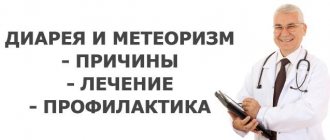There are many reasons for diarrhea. The disorder can cause both elementary overeating and inflammation of the intestinal walls. Diarrhea of bacterial origin is diarrhea that is caused by exposure to pathogenic bacteria. They enter the body along with stale or contaminated foods and multiply quickly, suppressing the natural intestinal microflora.
The most common pathogens of invasive infectious diarrhea in children
Echerichia coli (enteroinvasive and enterohemorrhagic strains)
DIAGNOSTIC CRITERIA
increase in body temperature to 38-40°C;
symptoms of infectious toxicosis, possible development of toxic encephalopathy (impaired consciousness, convulsions);
cramping abdominal pain;
tenesmus or tenesmus equivalents;
spasmodic sigmoid colon;
loose stools with a small amount of feces, often green;
in the stool there is an admixture of mucus, blood, and less often - pus
severity of intoxication symptoms;
nature, frequency of bowel movements, presence of hemocolitis;
intensity of abdominal pain;
presence and nature of complications
Coprogram (mucus, leukocytes, erythrocytes, columnar epithelial cells).
Stool culture (for salmonellosis - urine and blood are additionally cultured).
Agglutination reaction, passive hemagglutination reaction (increase in antibody titer over time). It is advisable to carry them out in children over 1 year of age in the absence of positive results of bacteriological examination.
1. Antibacterial therapy.
Indications for antibacterial therapy:
All severe forms of the disease, regardless of etiology and age of the child
Hemocolitis, regardless of the child’s age and severity of the disease
Moderate forms of the disease in:
children over 1 year old with immunodeficiency conditions; HIV-infected children; children who are on immunosuppressive therapy; children with hemolytic anemia; shigellosis; amoebiasis; in the presence of secondary bacterial complications; in the presence of extraintestinal foci of infection
Mild forms of the disease in:
children 1 year of age with: immunodeficiency conditions; HIV-infected; children with hemolytic anemia; for shigellosis; amoebiasis; the presence of secondary bacterial complications.
Antibacterial therapy is not indicated for invasive intestinal infections:
Patients with mild forms of infection, except those listed earlier.
Patients with erased forms.
With bacterial carriage of any etiology (transient, post-infectious).
Patients with gastrointestinal dysfunction, which is associated with the consequences of acute intestinal infections (intestinal dysbiosis, lactase deficiency, celiac disease syndrome, secondary fermentopathy, etc.).
First-line antibacterial drugs (starter) are prescribed to patients with mild and moderate forms of the disease, empirically at the first meeting with the patient. These include: nitrofuran drugs and trimethoprim/sulfamethaxazole.
Antibacterial drugs of the 2nd line (alternative) are prescribed: if the drugs of the 1st line are ineffective, in patients with moderate and severe forms; during late hospitalization as starting drugs, mainly in the hospital. These include: nalidixic acid preparations and 2nd generation aminoglycosides (amikacin, netilmicin), except for salmonellosis.
Antibacterial drugs of the 3rd row are prescribed: for severe forms, moderate forms in children with immunodeficiency conditions, for children from orphanages who were born from parents of drug addicts and alcoholics, in case of ineffectiveness of 2nd row drugs, the occurrence of secondary bacterial complications, the presence of extraintestinal foci of infection, suspected hospital infections forms of infection, only in a hospital. These include: a) aminopenicillins, protected from the beta-lactamase activity of pathogens (in the presence of flora sensitive to them); b) 3rd generation cephalosporins (cefotaxime, ceftriaxone); c) carbopenems (imipenem, meropenem); d) fluoroquinolones (only for health reasons).
In severe septic forms of acute intestinal infections, the combined use of 2-3 antibiotics is possible:
a) 3rd generation cephalosporins + aminoglycosides;
b) aminopenicillins protected from the action of beta-lactamases + aminoglycosides.
The course of antibacterial therapy is 5-7 days.
For giardiasis, amoebiasis, balantidiasis - metronidazole.
The indication for replacing the drug is its ineffectiveness within 3 days.
For septic forms (salmonellosis, yersiniosis, campylobacteriosis), treatment is carried out according to the sepsis treatment protocol.
2. Rehydration therapy.
With invasive acute intestinal infections, dehydration of the child’s body is relatively rare. If available, preference is given to oral rehydration methods using glucose-saline solutions.
3. Detoxification therapy
carried out in the presence of symptoms of infectious toxicosis. For mild and moderate forms, oral rehydration solutions are used for this purpose; in severe forms - intravenous administration of isotonic solutions of glucose, sodium chloride, colloidal solutions (dextrans).
4. Supportive therapy:
a) enterosorption: preference is given to silicate sorbents, which are prescribed from the first days of the disease. The course of enterosorption for OKI is 5-7 days. The criterion for early drug withdrawal is normalization of bowel movements or delay of bowel movements for 2 days.
b) probiotic therapy as etiotropic in the absence of antibacterial drugs in the prescriptions. The course of probiotic therapy in the acute period of ACI lasts 5-7 days. Probiotic therapy is also indicated during the period of convalescence of acute intestinal infections with physiological probiotics (containing normal microflora) in order to restore the intestinal microflora within 3-4 weeks.
c) enzyme therapy is prescribed in the convalescence stage of acute intestinal infections in the presence of signs of dysenzymeopathy. Pancreatic preparations are used (pancreatin, etc.). The course of enzyme therapy is 2-3 weeks.
In the acute period of ACI, it is recommended to reduce the daily volume of food by 1/3-1/4. It is possible to increase the frequency of feedings to 8-10 times a day in infants and with the urge to vomit. Today, the most physiological is considered to be early, gradual restoration of nutrition. The restoration of the qualitative and quantitative composition of food is carried out in the shortest possible time.
Older children are advised to follow a gentle diet; whole milk, carbohydrate-rich, fatty, fried, smoked and roughage foods are excluded from the diet.
In children 1 year of age, breastfeeding should be maintained. Children who are bottle-fed in the acute period of acute intestinal infections are given regular adapted milk formulas. Feeding with low-lactose mixtures is possible. You can prescribe baked apples, fermented milk products, potato and carrot puree in water. Introduction to the diet of foods rich in pectins (baked apples, bananas, applesauce).
COMPLICATIONS
(treatment is carried out according to appropriate protocols):
https://youtu.be/I8KymVVLJnM
Diet
During treatment of an infectious disease that is accompanied by diarrhea, it is necessary to adhere to a strict diet. It will help quickly restore normal functioning of the gastrointestinal tract and relieve many symptoms, especially those associated with irritation and inflammation of the intestinal walls.
Products prohibited during this period:
- fatty, fried, smoked meat, fish, sausages;
- carbonated drinks;
- alcohol;
- spicy dishes;
- any canned food;
- baked goods, rye bread;
- fresh vegetables;
- legumes;
- pearl barley;
- milk, sour cream, fermented baked milk.
Can be eaten:
- crackers;
- porridge with water, boiled rice;
- tea;
- jelly;
- boiled vegetables;
- lean meat and steamed fish;
- dill.
Preventive measures to prevent infectious diseases and diarrhea consist of the most common rules known from childhood:
- wash your hands with soap before eating and after visiting the toilet;
- wash fruits and vegetables thoroughly before eating;
- do not eat unfamiliar or stale foods of unknown origin;
- strictly follow the rules of thermal cooking when preparing dishes;
- drink clean water from known sources or boil it for at least 20 minutes before drinking;
- do not contact with infectious patients;
- observe quarantine for the duration of the incubation period, from 6 hours to 3 days;
- supervise small children, not allowing them to put dirty toys and objects picked up from the ground into their mouths;
- observe the rules of personal hygiene;
- keep your home and kitchen clean, regularly perform wet cleaning, and wash dishes thoroughly;
- carry out antiparasitic and anthelmintic treatment of pets in a timely manner;
- lead a healthy lifestyle, get rid of bad habits;
- timely treatment of chronic diseases.
Infectious diarrhea, if not treated promptly or self-medicated, can lead not only to dehydration, but also to serious inflammatory complications, and the diarrhea itself will become chronic. A prolonged or chronic form may indicate serious health problems - cancer, problems with the pancreas, ulcerative colitis, and other gastroenterological diseases.
The best cure for bacterial diarrhea in most cases is diet. Maintaining a proper diet helps normalize the functioning of the gastrointestinal tract. Undoubtedly, to combat diarrhea of bacterial origin it is necessary to use pharmacological drugs, but the lack of diet significantly reduces their effectiveness.
There are general recommendations that must be followed if you have bacterial diarrhea:
- give up nicotine and alcohol;
- nutrition should be balanced, rich in protein;
- limit intake of fatty, fried, smoked, canned foods;
- dishes should be as dietary as possible so as not to create additional stress on the gastrointestinal tract.
The diet for diarrhea should be rich in pectins. Fibers of plant origin, which easily dissolve in water, help normalize microflora. Pectins are found in fruit purees, yoghurts, and bananas.
Bacterial (invasive) diarrhea
Infectious type of diarrhea is considered one of the most common diseases. Its prerequisite may be the entry into the body of harmful microorganisms of the genus Shigella, Salmonella, the staphylococcus family and others.
The cause of bacterial diarrhea is various microbes, the action of which in the body disrupts the natural functioning of the microflora and gastrointestinal tract. Bacterial (invasive) diarrhea is a fairly common problem that has a wide range of symptoms and possible pathologies. Depending on what microorganism the patient was infected with, the clinical picture of his illness will be determined.
When to see a doctor
Bacterial diarrhea is accompanied by a clear deterioration of the condition. If with food poisoning the diarrhea does not last long, and with inflammation the temperature often remains normal and no vomiting is observed, then with an infectious infection all the signs of a serious condition are recorded.
You should consult a doctor immediately if you experience an increase in temperature. Also, do not postpone the visit if blood, mucus, or green inclusions are found in the diarrhea.
A clear confirmation of the bacterial origin of diarrhea is its occurrence in several family members.
Symptoms of bacterial diarrhea
The picture of the disease has significant differences depending on the microorganism that provoked the disease. The main symptoms of bacterial diarrhea are usually:
- frequent loose stools of varying intensity;
- pain in various areas of the abdomen, cramps;
- heat;
- nausea with vomiting;
- headache and general malaise.
A very dangerous consequence of bacterial diarrhea is dehydration. With some diseases that cause severe diarrhea, in particular cholera, a critical level of dehydration can occur, which can be fatal. Therefore, it is imperative to monitor the patient’s condition for fluid loss by the body and immediately take measures to restore water balance.
Treatment of bacterial diarrhea
Despite the presence of infection in the body, the most life-threatening consequences for the patient are the consequences of dehydration.
The main risk groups, naturally, are children, the elderly and those who, for one reason or another, have a weakened immune system. Invasive diarrhea in these groups can have particularly dangerous consequences, so its treatment should be carried out under the supervision of a specialist. First of all, it is necessary to carry out a set of actions to restore water balance by taking rehydration medications or glucose-containing liquid. The diet is subject to strict adjustment; all foods that can harm the healing process or provoke a new round of illness (dairy, spicy, sour, fatty foods, alcohol) are excluded from the diet. The advisability of using antibiotics during the treatment of bacterial diarrhea can only be determined by a doctor.
Diagnostics
Considering the fact that infectious diarrhea syndrome can be caused by a fairly wide range of pathogens, it is important to make a correct diagnosis in a timely manner.
Often, identifying the causative agent of an intestinal infection is extremely important, especially with cholera, botulism and other infections.
When making a preliminary diagnosis of “infectious diarrhea,” a study of feces, washing water, blood, vomit, and urine is used to clarify the causative agent.
The following methods are used:
- sowing of feces (for intestinal flora, opportunistic flora, Yersinia, Campylobacter);
- examination of stool for Vibrio cholerae;
- immunological studies (stool and blood serum) using ELISA, RNGA;
- the PCR method can detect pathogenic Shigella, Yersinia, causative agents of cholera, salmonellosis, campylobacteriosis, escherichiosis, and viruses;
- Using a toxicological study of washing water, food debris, feces, and blood, the presence of botulinum toxin can be detected (diagnosis of botulism).
General clinical methods and additional studies (if indicated) are also used.
When visiting a doctor, it is necessary to clarify the time of onset of symptoms, the nature of the pain, the consistency and frequency of stool. You also need to pay attention to trips to hot countries and changes in diet.
They conduct a study of discharge, analyze stool for blood, bacteria and parasite cysts. If the disease is inflammatory in nature, cultures are examined for the presence of salmonella, shigella or campylobacter. Diagnostics are also carried out for cytotoxins, vibrios and specific antibodies in the patient’s blood.
After examining the abdomen, the doctor may prescribe an ultrasound of the abdominal organs to determine the extent of the infection in the pancreas, gallbladder and liver. Blood counts are also monitored to assess the inflammatory process.
Often food intoxication (for example, botulism) is behind intestinal inflammation, so it is important to pay attention to the quality and expiration date of food. If you have consumed unusual foods, be sure to tell your doctor at your appointment.
Bacterial (invasive) diarrhea
Diarrhea
of infectious origin are observed quite often. It leads to significant economic losses associated with temporary disability of workers. This pathology is one of the common causes of death in children under five years of age. Protection of the intestines from pathogenic microorganisms is carried out with the help of gastric juice, bile salts, immune factors of the mucous membrane, as well as substances secreted by normal microflora.
Infection occurs through the fecal-oral mechanism
, when consuming contaminated food and water. Only ten pathogens (Shigella) are enough to cause an infection. Eating certain foods (milk) or taking medications (histamine H2 receptor blockers and proton pump inhibitors) helps reduce the protective properties of gastric juice.
Bacteria get into food from infected animals
, as well as due to non-compliance with sanitary standards in slaughterhouses and when selling meat. Eggs from salmonella-infected chickens may also be contaminated with the bacteria. Improper storage and preparation of food contributes to the survival and proliferation of microorganisms.
Transmission of infection
easier in conditions of unsanitary conditions, wars or migration of refugees. In such a situation, the disease spreads quite quickly and is characterized by high mortality. Cholera is capable of rapidly spreading across many countries and continents (pandemic).
Traveler's diarrhea usually develops within 72 hours
arrival in a new country. The risk of developing the disease is highest in Latin America, Africa and Asia. Loose, watery stools are observed 2-4 times a day, and there is usually no blood or mucus in the stool. In most cases, diarrhea is caused by enterotoxigenic and enteroadhesive strains of Escherichia coli.
Main role in treatment
restoration of water and electrolyte balance in the body, as well as the prescription of antibacterial drugs (co-trimoxazole or ciprofloxacin) plays a role.
Diarrhea caused by C. difficile
is one of the most common nosocomial infections.
Causes
There are many possible reasons for the development of diarrhea:
- Bacterial infectious diseases (salmonellosis, cholera, etc.), as well as food poisoning caused by staphylococci, pathogenic E. coli.
- Rotavirus infection.
- Crohn's disease.
- Ulcerative colitis.
- Congenital enzymopathies (for example, lactose intolerance).
- Chronic pancreatitis.
- Incorrect use of laxatives.
- Overeating, especially with the abuse of fatty foods that the digestive system cannot digest normally.
- Eating unusual foods.
- Stress (a classic example is “bear disease”).
- Irritable bowel syndrome.
Treatment of infectious diarrhea
Treatment of diarrhea of infectious origin is selected after conducting the necessary examinations. Therapy is selected after identifying the pathogen, but taking into account the individual characteristics of the organism.
The general principles of treatment of infectious diarrhea are to use:
- Hydration of the patient. The essence of the method is to replenish water reserves lost during illness.
- The use of antidiarrheal drugs (for example, Loperamide);
- Taking probiotics (normalization of microflora);
- Symptomatic therapy (antipyretics, painkillers);
- Antibiotic therapy. Can be empirical and targeted. Empirical remedies are taken while awaiting examination results (so that treatment can be started without wasting time) or for an infection of unknown origin. Targeted antibiotic therapy is selected taking into account the effect of a particular group of drugs on a specific pathogen.
Treatment is selected individually by the doctor. Self-medication may not bring the desired results or worsen the patient's condition.
Treatment methods
Elimination of infectious diarrhea requires supervision by the attending physician. First of all, it is important to find out what exactly caused the diarrhea, and then prescribe treatment to eliminate the causative agent and normalize well-being.
Treatment for viral diarrhea usually involves only a symptomatic approach. The patient needs to drink enough fluid to restore fluid balance. If signs of dehydration appear, the lack of fluid must be replenished with the help of rehydration drugs, for example, Regidron.
To normalize well-being the following are also used:
- Antipyretics – acetylsalicylic acid, Paracetamol.
- Adsorbents – activated carbon, Polyphepan.
- Probiotics – Linex, Bifidumbacterin.
- Antidiarrheal drugs – Loperamide, Smecta.
Antiviral drugs are not prescribed in all cases, because the immune system of a healthy person is able to cope with the virus on its own while the laboratory is trying to accurately determine the causative agent of diarrhea. But in case of pathologies of the immune system or in severe cases of the disease, special medications can be used to combat viruses. To do this, you need to accurately determine its type.
For diarrhea of bacterial origin, antibiotics are required. First, the doctor prescribes broad-spectrum antibiotics, but then can choose a targeted drug, focusing on laboratory tests, if the first drug did not have the desired effect.
Nutrition is also of great importance. On the first day of the disease, you need to refuse food in favor of drinking plenty of fluids. With severe diarrhea, the beneficial elements will still not be absorbed, but the digestive tract will be overloaded. Sometimes diarrhea can last a long time even when the causative agent is eliminated due to the fact that the gastrointestinal tract cannot digest heavy foods and dishes. Until complete recovery, you should not eat spicy foods, foods rich in fiber, or milk.
If your health deteriorates significantly, you should call emergency medical services. While waiting for her, it is necessary to replenish the loss of electrolytes and reduce body temperature with a cold towel.
Treatment of infectious diarrhea lasts from two to three days to 2 weeks.
If the treatment was carried out promptly and correctly, then the prognosis is favorable and no dangerous consequences arise. The most dangerous complication of diarrhea is dehydration, which most often develops in infants.











